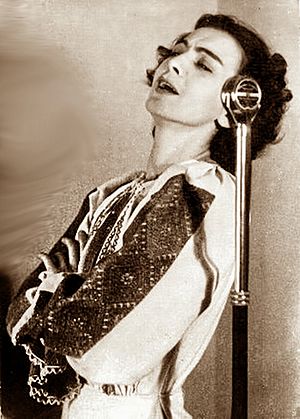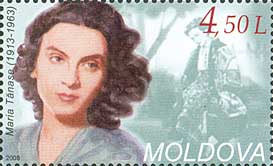Maria Tănase facts for kids
Quick facts for kids
Maria Tănase
|
|
|---|---|
 |
|
| Born | 25 September 1913 |
| Died | 22 June 1963 (aged 49) Bucharest, Romanian People's Republic
|
| Resting place | Bellu Cemetery, Bucharest |
| Occupation | Singer, actress |
| Years active | 1934–1963 |
| Spouse(s) | Clery Sachelarie (m. 1950–63) (her death) |
Maria Tănase (Romanian pronunciation: [maˈri.a təˈnase]; born September 25, 1913 – died June 22, 1963) was a famous Romanian singer and actress. She sang many types of music, from traditional Romanian folk songs to tango and operetta.
Maria Tănase is as important in Romania as Édith Piaf is in France. She was known as Romania's national diva. People loved her for her unique voice, beauty, and charm. Many still see her as a major cultural icon from the 20th century. In 2006, she was named one of the 100 Greatest Romanians ever.
Some of her popular songs include Cine iubește și lasă (1937), Leliță cârciumăreasă (1939), and Ciuleandra (1956).
Contents
Her Early Life and Career Beginnings
Maria Tănase was born in a part of Bucharest called Cărămidarii de Jos. Her father, Ion Coanda Tănase, was a gardener and florist. He owned a large plant nursery. Women from different parts of Romania worked there. They often shared traditional folk songs and stories. Young Maria loved listening to these songs. They had a big impact on her.
She first performed on stage in her hometown. In 1934, she joined the "Cărăbuş" Theatre. A writer named Sandu Eliad helped her. Her first real show was on June 2, 1934, using the name Mary Atanasiu.
In late 1937, she recorded her first folk songs. Her voice was first heard on the radio on February 20, 1938. Soon, she became famous both in Romania and other countries. She even represented Romania at the 1939 New York World's Fair.
Maria Tănase During World War II
During World War II, Maria Tănase performed for soldiers. She sang with other famous artists like George Enescu. In December 1943, she sang at a Christmas party for the Royal Cavalry Regiment. Important people like King Michael I were there. In 1944, Maria Tănase also acted in an operetta called "Mascota."

Later Career and Achievements
After World War II, Maria Tănase continued to perform. She acted in plays like "The Living Corpse" in 1945. She also starred in a musical comedy called "The Hollywood Sphinx" in 1946. Maria Tănase sang in the movie "Romania" in 1947. In 1958, she appeared in two more films. She traveled a lot for her music, even visiting New York City over forty times.
In 1952, Maria Tănase started teaching. She got a job at the Music School No. 1 in Bucharest. She taught traditional folk songs in a new department. In 1962, she helped guide a folk music band called "Taraful Gorjului."
Sadly, on May 1, 1963, she had to stop her tour because she became very sick. Maria Tănase died of cancer on June 22, 1963. She was buried in the Bellu Cemetery in Bucharest.
Maria Tănase received many awards for her contributions to art. In 1955, she got the State Prize. In 1957, she was given medals and the title "Honoured Artist of the Republic." Many Romanians remembered her as their own Édith Piaf, a famous French singer. Maria Tănase passed away at 49. Many people filled the streets of Bucharest to honor her after her death. She helped make Romanian folk music popular.
Her Music Albums
Maria Tănase released many albums during and after her lifetime. Here are some of them:
| Year | Title | Label |
|---|---|---|
| 1994 | Greatest Hits | Intercont Music |
| 1994 | Maria Tănase Volume I | Electrecord |
| 1997 | Maria Tănase Volume II | Electrecord |
| 2000 | Maria Tănase Volume III | Electrecord |
| 2000 | Malediction d'Amour | Oriente Musik |
| 2001 | Ciuleandra | Oriente Musik |
| 2002 | Magic Bird – The Early Years | Oriente Musik |
| 2007 | Maria Tănase part I | Jurnalul Național |
| 2007 | Maria Tănase part II | Jurnalul Național |
| 2008 | Discul de aur | Jurnalul Național |
| 2011 | Anii '30–'40 | Electrecord |
| 2013 | Cântece popular. 1953–1961 | Editura Casa Radio |
Her Lasting Legacy
Maria Tănase left a big mark on Romanian culture. Many famous people admired her.
- In 1939, the famous sculptor Constantin Brâncuși met Maria Tănase. He told her, "When I hear you singing, Maria, I would be able to carve for each song of ours a Bird in Space!" He saw her as a "symbol of all Romanians."
- The famous Russian singer Lydia Lipkowska was also amazed by her. She said Maria's voice deeply moved her.
- Nicolae Iorga, a well-known Romanian historian, called her "Pasărea măiastră," which means "The Majestic Bird."
- Writer Mihail Sadoveanu thought she was the "first authentic rhapsodist" of the Romanians. A rhapsodist is someone who performs epic poems or songs.
- Herta Müller, who won the Nobel Prize in Literature in 2009, said Maria Tănase greatly influenced her. She felt Maria's music truly showed what folklore meant.
- British musician Nigel Kennedy and the Polish band Kroke honored her. They released a song called "Tribute to Maria Tănase" in 2003.
- The character Florica in a novel series called Fortunes of War was based on Maria Tănase.
- In 2013, the music group Pink Martini said Maria Tănase was one of their biggest inspirations. They even covered her song Până când nu te iubeam.
- Also in 2013, Romanian singer Oana Cătălina Chițu released an album called Divine. It featured songs from Maria Tănase's collection.
- On September 25, 2013, Google Romania celebrated Maria Tănase's 100th birthday with a special doodle on their homepage.
See also
 In Spanish: Maria Tănase para niños
In Spanish: Maria Tănase para niños


